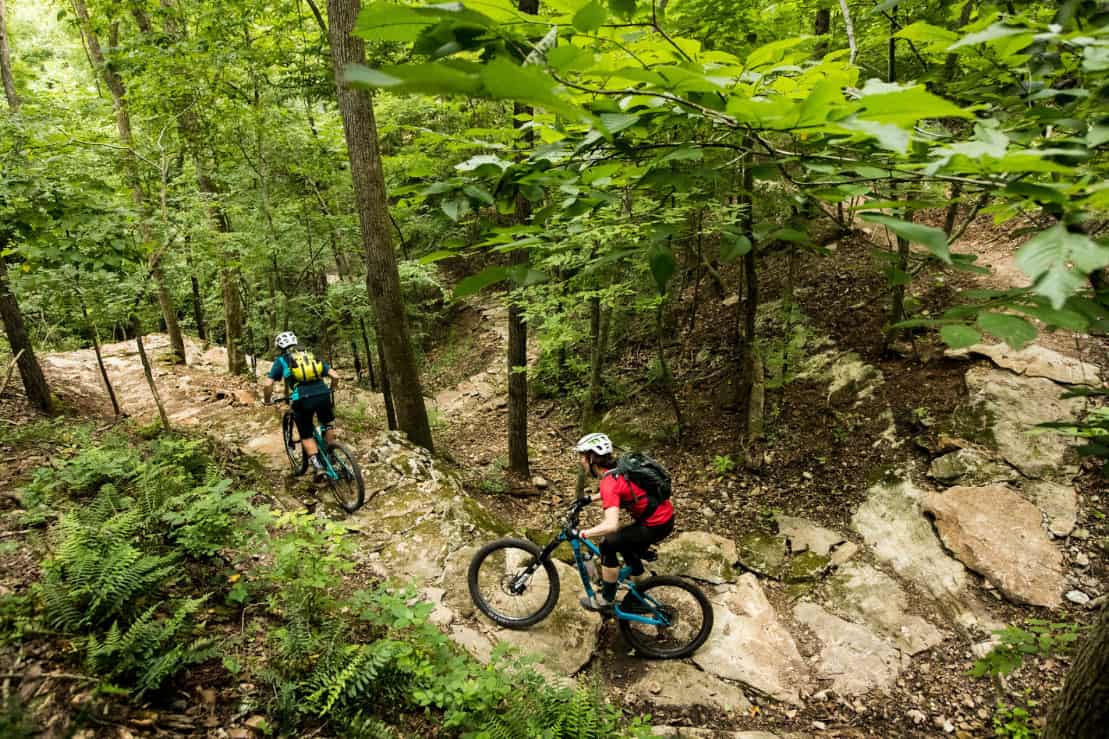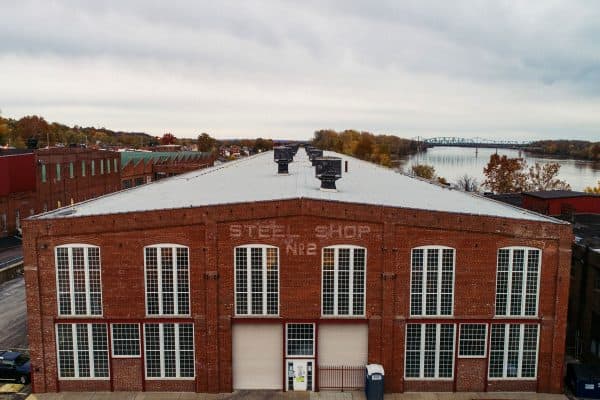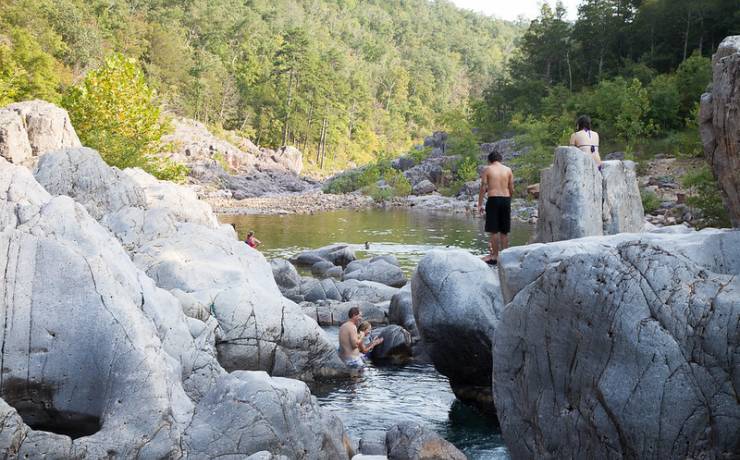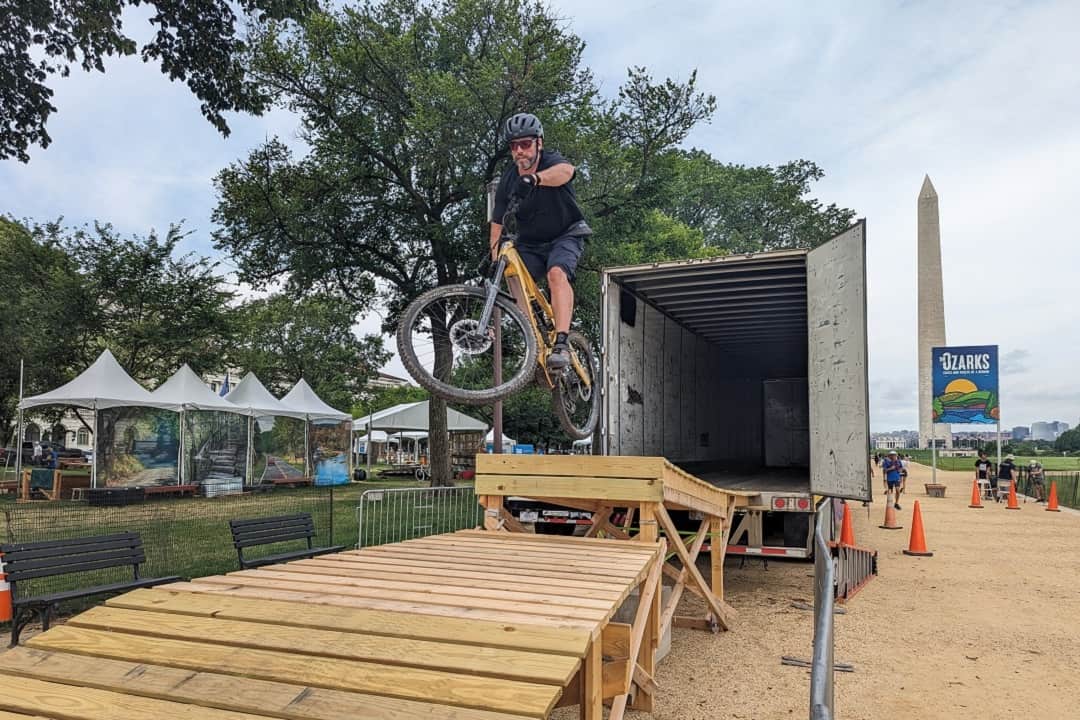Imagine the U.S. Government reaches out and asks you to build a mountain bike park in the President’s backyard. That’s exactly what happened to 31-year-old Missouri resident Seth Gebel last summer.
The 2023 Smithsonian Folklife Festival, an annual exposition of living cultural heritage, had chosen “The Ozarks: Faces & Facets of a Region” as its theme. In addition to storytelling, music and dancing, food, arts and crafts, and presentations on indigenous inhabitants, agriculture, and more, organizers felt that, due to its contemporary importance to the region, mountain biking deserved a spot front and center at the celebration.
Gebel, who lives just outside of St. Louis and develops handmade mountain bike features as part of his business Backyard Trail Builds, was tasked with creating a makeshift bike park on the National Mall in Washington, D.C.
“I was way too excited to be doing something for the Smithsonian. Everything with the festival matched or exceeded my expectations,” Gebel said. “People’s reactions were always filled with confusion and surprise.”
That sense of surprise is understandable. Nestled against iconic structures like the Washington Monument, the mountain bike park was a striking scene, with demonstrators ripping down a trail, riding through a painted shipping container, and soaring off ramps and across gaps against the backdrop of the U.S. Capitol building.
The Smithsonian Folklife Festival not only showcased Ozark culture on the national stage but also captured the region’s deep connection to the outdoors and its up-and-coming status as a player in America’s recreation industry.
***
Like that mountain biking attraction on the National Mall, the Ozarks region itself unfolds in an unexpected way. The hills and hollers consist of lush green forests, grassy glades, spring-fed rivers, rugged bluffs, and steep gorges — a mixed landscape that is mirrored in the recreational experiences it presents and the outdoor industry it nurtures.
When Aaron Arnzen lines up on his gravel bike at the Dirty South Roubaix in the Illinois Ozarks, it feels like he’s a kid all over again. He describes the race as “pure off-road fun.” Arnzen grew up riding with neighborhood friends and using his bike as a means for hauling spaghetti home from Grandma’s house. The Dirty South Roubaix, and indeed the entire Ozark gravel biking community, has provided the 29-year-old with a way to hold onto that sense of youthful freedom and wonder.
Meanwhile, in northeast Oklahoma, Lyndsey Yarger (age 27) is honing her skills as a novice whitewater kayaker. The Siloam Springs Whitewater Recreation Park on the western edge of the Ozarks near the Oklahoma/Arkansas border is a perfect spot for practicing how to catch eddies, navigate drops, and control her momentum. Just 10 years ago, a safe, reliable, and easily accessible place for Yarger to learn whitewater skills was non-existent.
As gravel is grinded and waves surfed, the community also comes together in local gear shops and outfitters, coffee houses and breweries, and hotels and Airbnbs. The outdoor recreation economy in the Ozarks has undergone significant growth over the past decade — a trend accelerated by the COVID-19 pandemic.
In Arkansas, the outdoor recreation economy has surged, growing to an impressive $4.1 billion GDP for 2022. Missouri’s outdoor economy showed even more growth while surpassing pre-pandemic levels. In 2022, the state’s outdoor recreation accounted for $8.8 billion in GDP. This was an increase of about $900 million from 2021. Outdoor recreation contributed 2.2 percent to Missouri’s economy while boasting a 61-percent participation rate.
Together, the Missouri and Arkansas outdoor economies represent over $12 billion in GDP and 133,000 jobs.
This regional growth reflects a broader national trend, with outdoor recreation becoming a major economic driver across the U.S. Nationally, the sector generates $1.1 trillion in economic output, comprises 3.2 percent of the workforce, and creates 5 million jobs. It surpasses the economic output of industries like oil, gas extraction, and mining — combined.
The success of the outdoor recreation economy during and after the pandemic highlights its resilience and the potential for continued progress, especially in the Ozark region.
***
But outdoor industry growth in the Ozarks isn’t limited to just the last three years. Over the past decade, the region has seen countless new attractions, entrepreneurial initiatives, and brand incubators that have all contributed to a robust recreation scene.
The list of new opportunities begins with a surge in mountain bike parks. These purpose-built venues offer diverse trail networks that cater to both beginner and seasoned riders, enhancing their appeal. In Missouri, spots like Howler Bike Park (near Branson) and Shepard Mountain Bike Park (Ironton) take advantage of the rugged natural features of the region and have given mountain biking a massive boost in popularity.

Coler Mountain Bike Park in Bentonville, Ark.
While Missouri’s growth in the sport is notable, it’s often overshadowed by the meteoric rise of progressive trail systems and mountain bike amenities in Bentonville and the northwest Arkansas area. (See our September/October 2020 and November/December 2019 issues.)
Gravel biking, another burgeoning sport, has found a fervent following in the Ozarks as well. Events like the aforementioned Dirty South Roubaix and The Epic in Lake Ozark, Missouri, have become annual highlights, drawing cyclists eager to navigate the network of old country roads. This growth in off-road biking is emblematic of a broader trend in the region — a move toward outdoor activities that lean into the Ozarks’ grueling topography and punchy spirit.
Not to be outdone by the cycling community, the paddling scene is keeping pace. Development of the WOKA and Siloam Springs whitewater parks in the southwestern Ozarks has added another dimension to sports by creating welcoming spots for paddlers and rafters of all skill levels. The racing community has blossomed as well; the Missouri River, flowing through the northern foothills of the Ozarks, is home to the MR340 (the longest nonstop paddle race in the world), the Race to the Dome, and other endurance events.
Races and attractions like those described above have a multiplier effect, spurring growth in related businesses like equipment rentals, training programs, and tourism services. These entrepreneurial initiatives have been pivotal in harnessing the Ozarks’ outdoor potential.
***
The region’s outdoor recreation industry has influence that extends beyond the specific sporting activities themselves. A key element of this influence is the growth of outdoor brands and manufacturers based in the region. These companies have not only helped put the Ozarks on the map as an industry hot spot, but they also create jobs and generate business opportunities for local communities.
Adam Brune of ALPS Mountaineering in New Haven, Missouri, attributes much of the brand’s success to its location. “One of the things that allows us to be successful is that we have good, honest, hard-working people here in our area,” said Brune, “and they make up a great team.” He also notes the logistical advantages of ALPS’ central U.S. location. Brune says the family-owned company is proud of the role it plays in providing local employment and supporting community activities.
Founded in 2008, Küat Racks of Springfield, Missouri, started in a simple pole-barn. Marketing Manager Kristy Taylor says the company is excited about its new, ultra-modern headquarters, which features several miles of on-campus trails. She lights up when talking about the area: “You know, we’ve got some really good trails, and we have people that are really pushing to develop more. This kind of access is just making our communities more enjoyable for everyone.”
Küat’s location also offers financial benefits due to lower costs of operation. Compared to outdoor industry hubs like Colorado and Carolina, the Ozarks offer more affordable living for employees. Taylor loves that “we have access to a ton of good outdoor experiences here for a great value. There are so many great things, from the Katy Trail to the Buffalo River…all of that stuff is so accessible for us, and there are so many cool, hidden gems.”

Climb So iLL Steel Shop indoor climbing gym.
David Chancellor, originally from the area, established Climb So iLL in St. Louis in 2012. This and a second climbing gym in St. Charles have grown significantly over the past decade and now function as community hubs — places for social interaction, relationship-building, and special events.
Chancellor spent a lot of time traveling as an up-and-coming climber and could have chosen to plant roots anywhere. But he recognized an untapped potential in his home region. “Southern Illinois, Missouri, and Arkansas had these magnificent resources for rock climbing, but they were under serviced and underdeveloped,” he said.
Chancellor says he started the gyms as a way to give back and help put the Ozark climbing scene on the map. “People think of our area as drive-through or flyover country, but we have so many hidden gems,” he said. Chancellor appreciates that the Climb So iLL gyms serve as gateways to the outdoor experiences he loves so much.
He’s also optimistic about the future of climbing in the region. “If you look at organizations like [nonprofit climbing advocacy group] Beta Fund, we’ve made several trips to Jeff City to sit down with decision makers. Now, we have a seat at the table and relationships with organizations like the Conservation Department and U.S. Forest Service,” Chancellor said. “We’ve been able to work through some of the processes and get buy-in that creates legitimacy in preserving some of these climbing areas.”
***
Luis Benitez, chief impact officer at Trust for Public Land, a national nonprofit that creates parks and protects public land so that everyone can access the benefits of the outdoors, sees the same buy-in and envisions a positive future for the outdoor industry in the Ozarks.
“For me, I point to things like the significant investment at Johnson’s Shut-Ins after the flood and how much usage increased afterward,” said Benitez, who was born and raised in St. Louis. “This means that when we treat these natural resources as vital infrastructure and take care of them, dollars will follow.”

Johnson’s Shut-Ins State Park. (MO State Parks)
Local nonprofits and community organizations have been instrumental in fostering the region’s outdoor spirit. While there are too many of these groups to name individually, their efforts often include spearheading trail development and maintenance, organizing cleanups and events, and advocating for environmental conservation. Their work not only preserves the natural beauty of the Ozarks but also ensures that outdoor activities remain accessible and enjoyable for everyone.
The data, as well as the connections and benefits, underscore the importance of conserving and investing in public lands, waters, and recreation infrastructure to sustain their health and prosperity, says Benitez.
As the outdoor recreation industry continues to grow and evolve, it stands poised to play an increasingly significant role in shaping the economic future of the Ozarks — and vice versa.
The Big Ones
In addition to the smaller businesses and nonprofits mentioned in this article, it’s impossible to mention the growth of outdoor recreation in the Ozarks without acknowledging the monumental contributions of the Johnny Morris Conservation Foundation (started by the founder of Bass Pro Shops) and the Walton Family Foundation (which continues a philanthropic vision of Walmart founders Sam and Helen Walton).
From Dogwood Canyon Nature Park and Top of the Rock Ozarks Nature Preserve, to WOKA Whitewater Park and the Coler Mountain Bike Preserve, the list of conservation and recreation projects supported by the two family-led organizations is extensive, enormous, and truly life-changing.
To learn more about the Johnny Morris Conservation Foundation, visit about.basspro.com/conservation/johnny-morris-wow-foundation/.
To learn more about the Walton Family Foundation, visit waltonfamilyfoundation.org/.
Author: John Holdmeier is a contributor to Terrain Magazine.
Top Image: At “The Ozarks: Faces & Facets of a Region” in Washington D.C. (Dave Schultz)


[…] city of West Plains in south central Missouri is both a firmly established Ozark oasis and an emerging outdoor recreation hub. Within a 75-mile radius of the warm and welcoming town, you […]
[…] for McCart and Kerby, self-proclaimed lovers of the outdoors. Both grew up canoeing, McCart in the Missouri Ozarks and Kerby in the Arkansas Ozarks. Additionally, Kerby learned to love surfing during his time […]